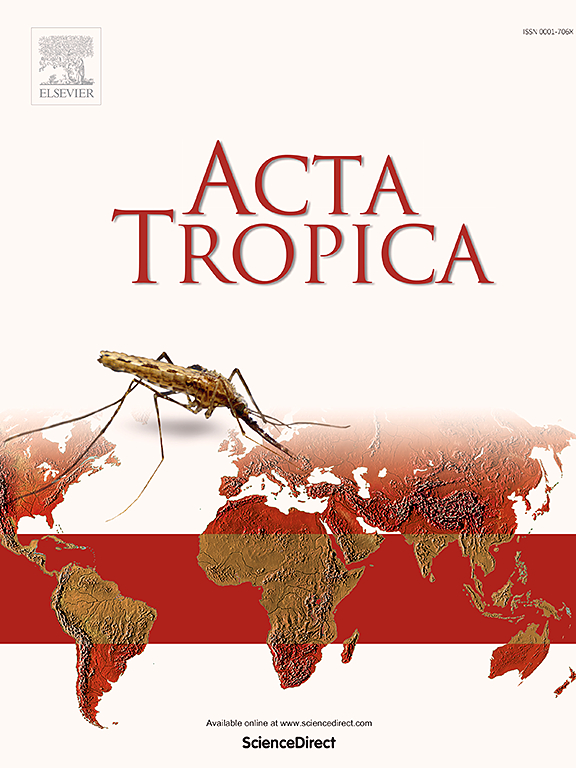2019 年加纳海岸角和德国慕尼黑疫情爆发所涉及的臭虫的分子鉴定和基因敲除抗性突变
IF 2.1
3区 医学
Q2 PARASITOLOGY
引用次数: 0
摘要
在世界范围内,臭虫侵扰的死灰复燃令人担忧,特别是两种常见臭虫物种的共同侵扰和杀虫剂耐药性的出现。为进行有效管理,有关特定物种及其杀虫剂抗性状况的信息至关重要。本研究调查了来自加纳海岸角和德国慕尼黑的臭虫种群在2019年虫害爆发中进化的特定物种和抗击倒(kdr)基因突变。在2019年虫害爆发期间,在加纳海岸角的家庭和教育机构以及德国慕尼黑的一个难民收容所收集了臭虫。采用世界卫生组织标准生物测定法测定了床虱对4种公共卫生杀虫剂的敏感性。采用细胞色素氧化酶亚基I (COI)基因和电压门控钠通道(VGSC)基因的聚合酶链式反应(PCR)扩增和Sanger测序,对所收集的臭虫进行种类和kdr突变的鉴定。在加纳发现的臭虫是C. hemipterus的两个亚群,它们都携带M918I和L1014F kdr突变。此外,该种群对有机氯、拟除虫菊酯、氨基甲酸酯和有机磷杀虫剂具有极强的抗性。德国的臭虫种群为L925I kdr突变的单种群。这是首次报道在撒哈拉以南非洲地区的半角弧菌中检测到多种kdr突变。这种昆虫对主要种类的杀虫剂具有极强的抗药性,这令人担忧,可能对公共卫生产生严重影响。本文章由计算机程序翻译,如有差异,请以英文原文为准。
Molecular identification and knockdown resistance mutation of bed bugs involved in 2019 outbreak in Cape Coast, Ghana and Munich, Germany
The worldwide resurgence of bed bug infestations is worrisome, particularly with the co-infestation of the two common bed bug species and emergence of insecticide resistance. For effective management, information on the specific species and their insecticide resistance status is crucial. This study investigated the specific species and knockdown resistance (kdr) gene mutations of the bed bug populations from Cape Coast, Ghana and Munich, Germany evolved in the 2019 infestation outbreak. Bed bugs were collected in households and educational institutions in Cape Coast, Ghana and a refugee shelter in Munich, Germany during the infestation outbreak in 2019. The susceptibility status of the bed bugs to four public health insecticides was determined using the standard WHO bioassay. Polymerase chain reaction (PCR) amplification of cytochrome oxidase subunit I (COI) gene and voltage-gated sodium channel (VGSC) gene followed by Sanger sequencing was used to identify the species and kdr mutations among the bed bugs collected. The bed bugs in Ghana were found to be two subpopulations of C. hemipterus, both of them harboring the M918I and L1014F kdr mutations. In addition, the population was extremely resistant to organochlorine, pyrethroid, carbamate and organophosphate insecticides. The bed bug population in Germany was a single population of C. lectularius with the L925I kdr mutation. This is the first report of the detection of multiple kdr mutations in C. hemipterus from Sub-Saharan Africa. The extreme resistance of the insect to the major classes of insecticides is a cause of concern and could have serious public health implications.
求助全文
通过发布文献求助,成功后即可免费获取论文全文。
去求助
来源期刊

Acta tropica
医学-寄生虫学
CiteScore
5.40
自引率
11.10%
发文量
383
审稿时长
37 days
期刊介绍:
Acta Tropica, is an international journal on infectious diseases that covers public health sciences and biomedical research with particular emphasis on topics relevant to human and animal health in the tropics and the subtropics.
 求助内容:
求助内容: 应助结果提醒方式:
应助结果提醒方式:


